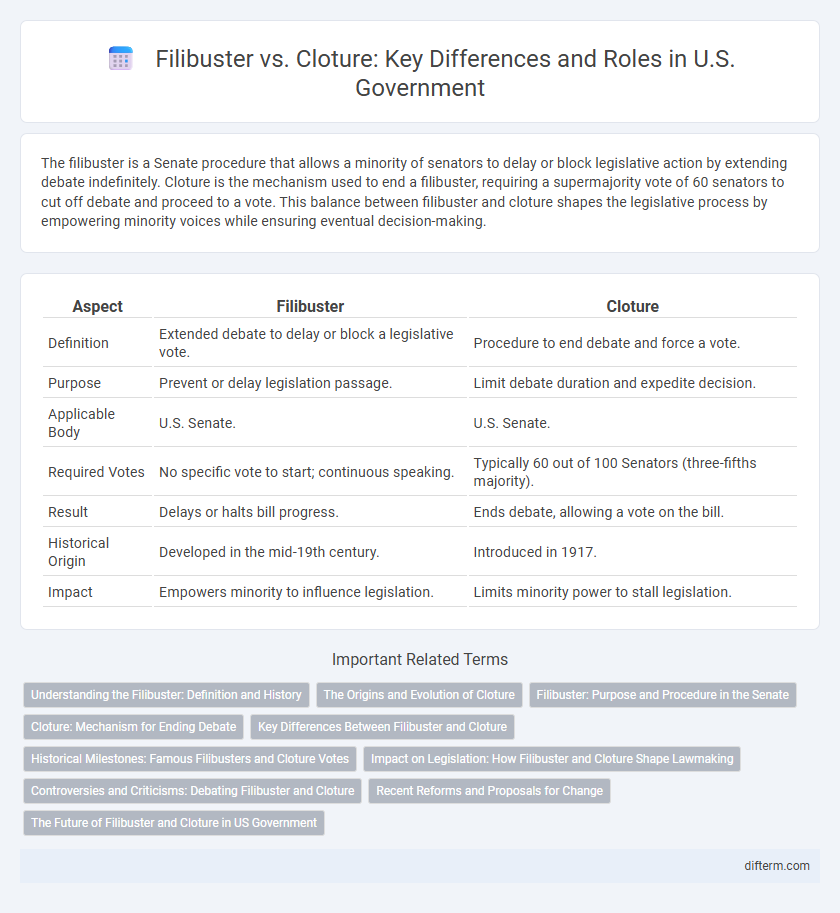The filibuster is a Senate procedure that allows a minority of senators to delay or block legislative action by extending debate indefinitely. Cloture is the mechanism used to end a filibuster, requiring a supermajority vote of 60 senators to cut off debate and proceed to a vote. This balance between filibuster and cloture shapes the legislative process by empowering minority voices while ensuring eventual decision-making.
Table of Comparison
| Aspect | Filibuster | Cloture |
|---|---|---|
| Definition | Extended debate to delay or block a legislative vote. | Procedure to end debate and force a vote. |
| Purpose | Prevent or delay legislation passage. | Limit debate duration and expedite decision. |
| Applicable Body | U.S. Senate. | U.S. Senate. |
| Required Votes | No specific vote to start; continuous speaking. | Typically 60 out of 100 Senators (three-fifths majority). |
| Result | Delays or halts bill progress. | Ends debate, allowing a vote on the bill. |
| Historical Origin | Developed in the mid-19th century. | Introduced in 1917. |
| Impact | Empowers minority to influence legislation. | Limits minority power to stall legislation. |
Understanding the Filibuster: Definition and History
The filibuster is a parliamentary procedure in the U.S. Senate that allows a minority to extend debate indefinitely, effectively blocking legislation unless a supermajority of 60 senators vote for cloture to end debate. Originating in the early 19th century, the filibuster evolved from Senate rules that permitted extended debate, becoming a powerful tool for minority opposition and requiring strategic negotiation to advance bills. Understanding its historical use reveals its impact on legislative gridlock and minority rights within the federal government.
The Origins and Evolution of Cloture
Cloture, established in 1917 by the U.S. Senate to counter filibusters, originated as a procedural motion requiring a two-thirds majority to end debate and proceed to a vote. Over time, its evolution included adjustments to the voting threshold, notably the 1975 reduction to three-fifths (60 senators), enhancing legislative efficiency while balancing minority rights. This mechanism remains critical in managing Senate deliberations and preserving the legislative process within the context of filibuster use.
Filibuster: Purpose and Procedure in the Senate
The filibuster in the Senate serves as a procedural tactic allowing Senators to extend debate indefinitely, effectively blocking or delaying a vote on a bill or nomination. Its purpose is to protect minority interests by requiring a supermajority of 60 votes to invoke cloture and end debate. This unique Senate rule emphasizes extended discussion and negotiation before legislation can proceed to a final vote.
Cloture: Mechanism for Ending Debate
Cloture is a parliamentary procedure used in legislative bodies, particularly the U.S. Senate, to end a filibuster and move forward to a vote. It requires a supermajority, typically 60 out of 100 senators, to invoke and thereby limit further debate on a bill or nomination. This mechanism ensures that prolonged obstruction does not impede the legislative process and enables the chamber to reach decisive outcomes efficiently.
Key Differences Between Filibuster and Cloture
The filibuster is a parliamentary procedure in the U.S. Senate that allows one or more senators to delay or block a vote by extending debate on a bill. Cloture is the mechanism used to end a filibuster, requiring a three-fifths majority (60 out of 100 senators) to limit further debate and proceed to a vote. The key difference lies in the filibuster's role as a means of obstruction versus cloture's function as a tool to restore legislative progress.
Historical Milestones: Famous Filibusters and Cloture Votes
The filibuster has played a pivotal role in U.S. Senate history, exemplified by Strom Thurmond's record 24-hour and 18-minute speech in 1957 opposing the Civil Rights Act. Cloture, established by the 1917 Senate Rule XXII, gained prominence during the 1919 struggle to end debate on the Treaty of Versailles. Landmark cloture votes, such as the 1975 reduction of the vote threshold from two-thirds to three-fifths, have significantly shaped legislative procedures by limiting filibuster use.
Impact on Legislation: How Filibuster and Cloture Shape Lawmaking
The filibuster significantly impacts legislation by allowing a minority of senators to delay or block bills, requiring extended debate and strategic negotiation. Cloture serves as the primary mechanism to end a filibuster, demanding a supermajority vote of 60 senators to proceed to final voting, thereby shaping legislative outcomes. This dynamic often slows lawmaking, influencing bipartisan cooperation and the passage of key policies in the U.S. Senate.
Controversies and Criticisms: Debating Filibuster and Cloture
The filibuster sparks controversy by allowing a minority of senators to indefinitely delay legislation, raising concerns about obstructing democratic processes and bipartisan cooperation. Cloture, designed to end filibusters by requiring a supermajority vote, faces criticism for enabling majority dominance and undermining extended debate. Debates over these Senate rules highlight tensions between protecting minority rights and ensuring legislative efficiency.
Recent Reforms and Proposals for Change
Recent reforms and proposals targeting the filibuster aim to address legislative gridlock in the U.S. Senate by modifying or abolishing the 60-vote cloture threshold required to end debate. Key proposals include lowering the cloture requirement for specific categories of legislation, such as budgets or voting rights, to a simple majority, thereby enhancing the efficiency of the Senate's legislative process. These reforms seek to balance minority rights with the need for timely decision-making amid increasing partisan polarization.
The Future of Filibuster and Cloture in US Government
The future of the filibuster and cloture in the US government hinges on ongoing debates over legislative efficiency and minority rights protection in the Senate. Potential reforms include adjusting the 60-vote threshold for cloture to streamline bill passage while preserving debate opportunities. Congressional proposals and public opinion increasingly influence how these procedural tools will shape the legislative process in coming years.
Filibuster vs Cloture Infographic

 difterm.com
difterm.com